AMD Kaveri Review: A8-7600 and A10-7850K Tested
by Ian Cutress & Rahul Garg on January 14, 2014 8:00 AM ESTDrawing Performance Conclusions
As I progressed through the testing for this review, I became aware of trends in two things: absolute performance, in terms of numbers, and generational improvements across platforms. With AMD moving the Bulldozer based architectures from Piledriver in Trinity and Richland to Steamroller in Kaveri, the base CPU design has had a relatively long run in order to be optimized to the limitations on the CPU side. Obviously AMD has also had a chance to change the lithography node in there as well, and as such has optimized for design rather than performance. This matters a great deal when we look at the power banding (45W, 65W, 95W) and performance in each segment.
In order to display just how much Kaveri has grown in relation to the previous generations, I processed our mountain of data to show graphs where percentage gain against the older generations really does matter. As mentioned previously in this review, it all depends on whether the software can take advantage of the new features afforded by the architecture. In this review we have spent a lot of time discussing advantages for Kaveri in terms of compute (HSA, hUMA, hQ) and gaming (Mantle, TrueAudio), but some of these are still a little way off for software integration. So what does that translate to if you are looking for an APU today – does Kaveri still expand its wings with the integration of the GCN architecture, or does it lag behind due to the lithography node no longer being optimized for frequency. The proof is in the results.
IGP Gaming, 1280x1024
For the 100W APUs at 1280x1024, there is almost no movement between the Richland and the Kaveri APUs, except for Company of Heroes which would seem to leverage the extra SPs more than the MHz available.
45W APUs are clearly in vogue at 1280x1024, each of them providing a good bump over Richland.
IGP Gaming, 1680x1050
1680x1050 sees more benefit for the 100W APUs, but the 45W APUs still show big leaps.
IGP Gaming, 1920x1080
At 1080p the effects are more pronounced all around.
CPU Timed Benchmarks
Unfortunately the CPU timed benchmarks at 100W are bit over the place. Here we are dealing with an IPC gain but MHz deficit, and each benchmark has a different way of dealing with it. For Agisoft, MHz wins, but for Xilisoft, the Kaveri improvements work out well for the system.
At 45W the situation is a lot more clearer, and the newer APUs have the advantage, especially in Adobe After Effects.
CPU Score Benchmarks
45W still makes the biggest jump when it comes to score based CPU benchmarks.
IGP Synthetics
I never like putting much thought into the synthetic results – here both the 100W and the 45W range are showing good improvements all around. 3DMark 06 has the most trouble getting improvements as it relies more on the grunt, rather than the features that Kaveri affords.
IGP Compute
Off the bat we can see just how much of a difference the Kaveri GPU Compute can make over previous APUs. This is still without hUMA fully being in effect while we wait for a proper driver and software stack to become available.
Up to a +222% boost from Kaveri is amazing for a 45W part.
AMD vs Intel
For a little tete-a-tete, putting the 65W Iris Pro up against the 65W Kaveri seems like a good idea. To add to the mix, due to the extreme price difference of Iris Pro in this equation, we also add the 95 W Kaveri for comparison.
It is interesting to note that at the lower resolutions the Iris Pro wins on most benchmarks, but when the resolution and complexity is turned up, especially in Sleeping Dogs, the Kaveri APUs are in the lead.


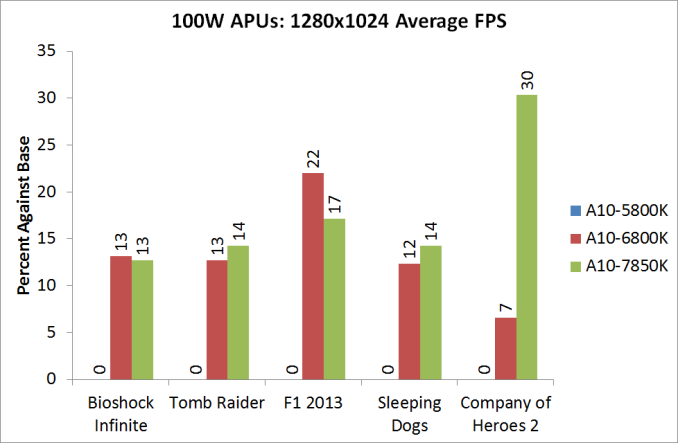
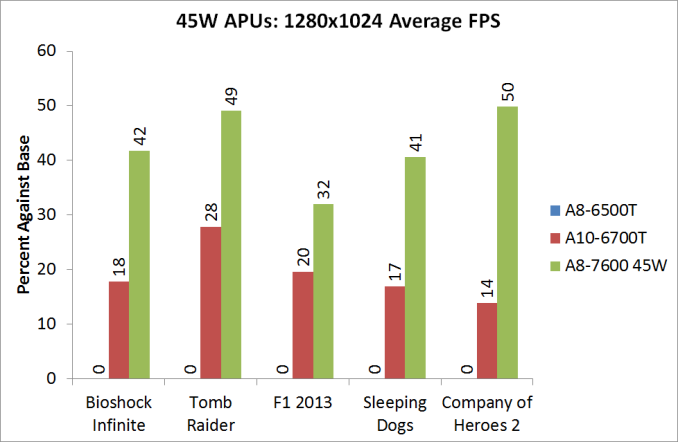
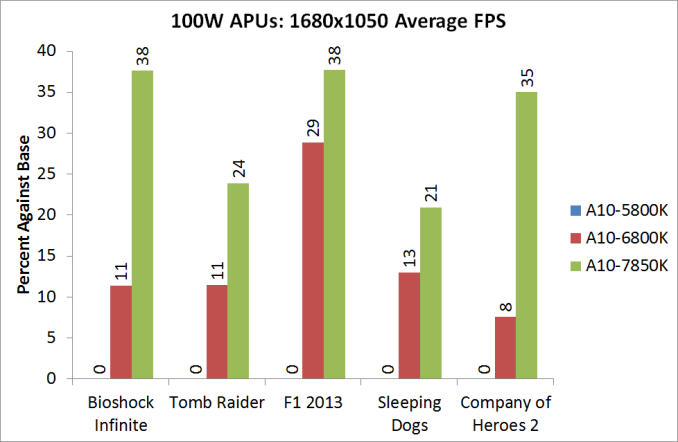
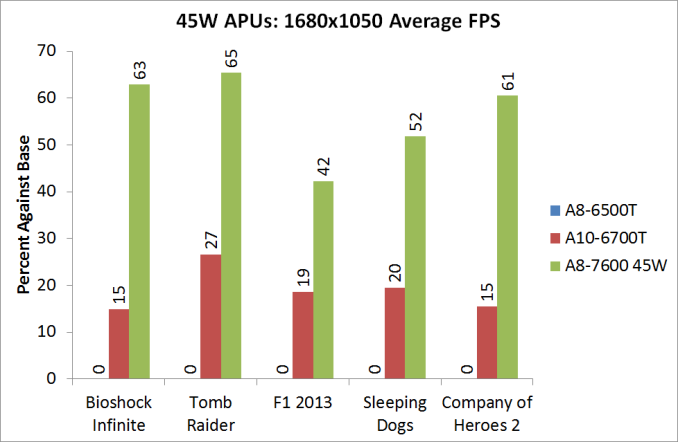
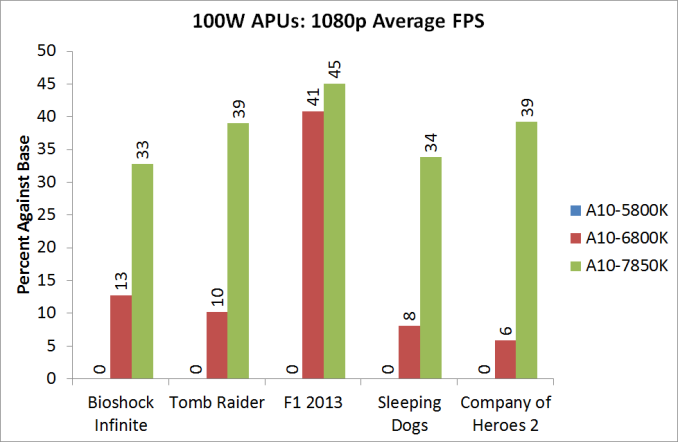

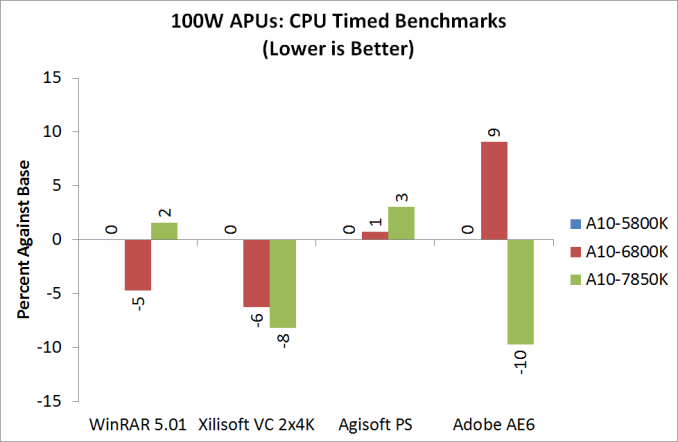
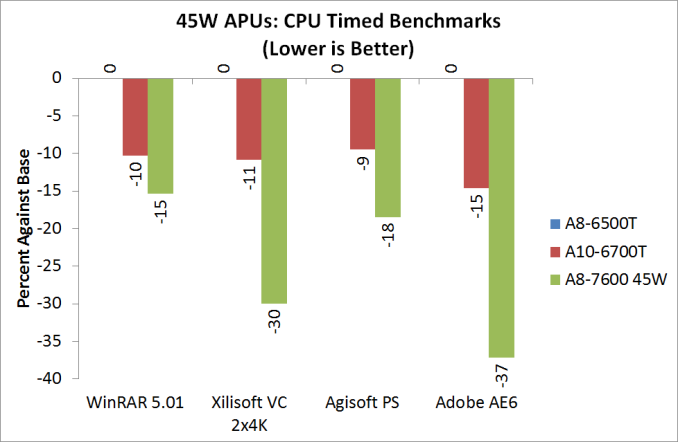

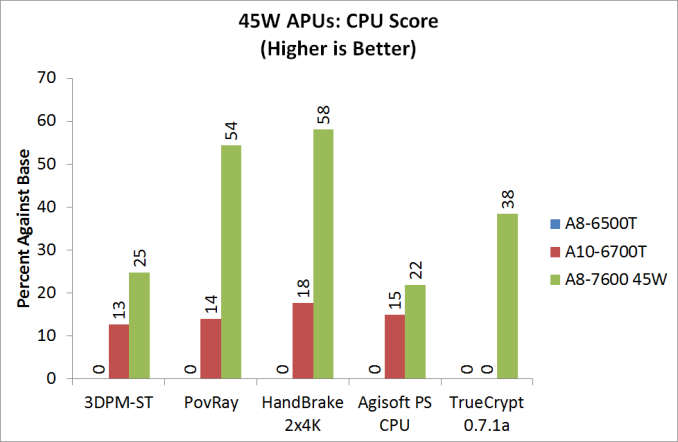
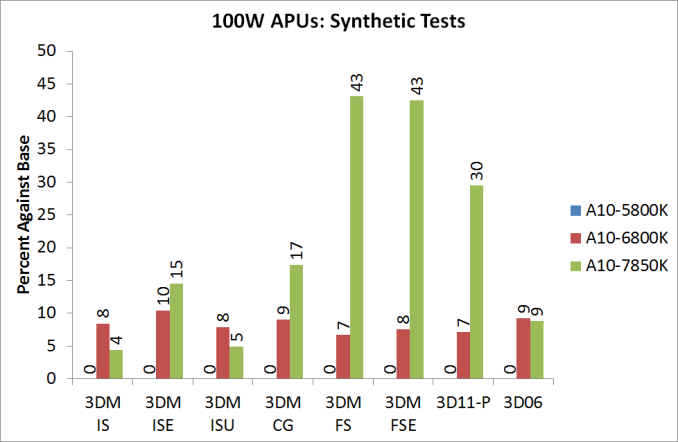
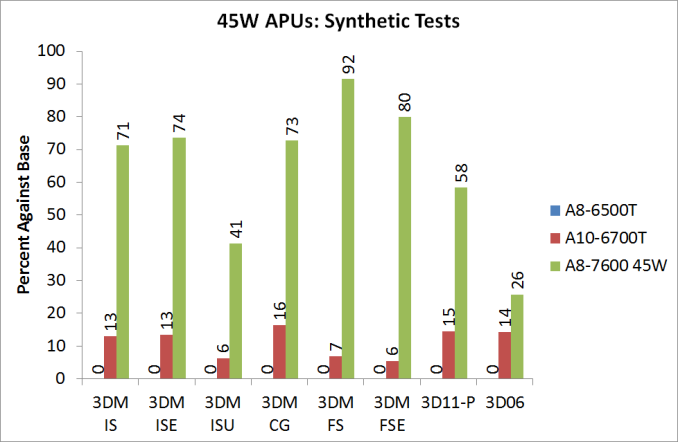
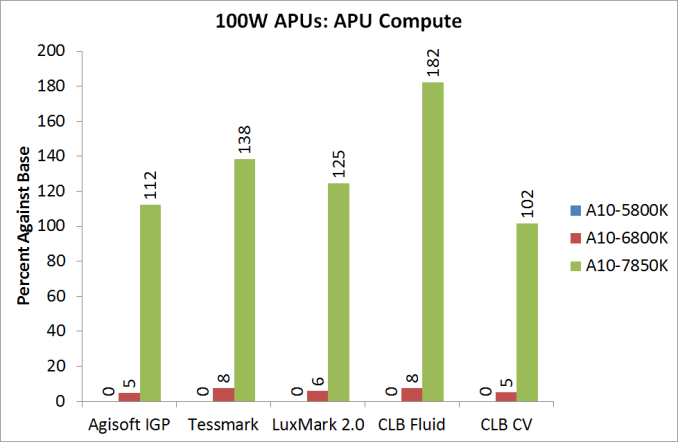

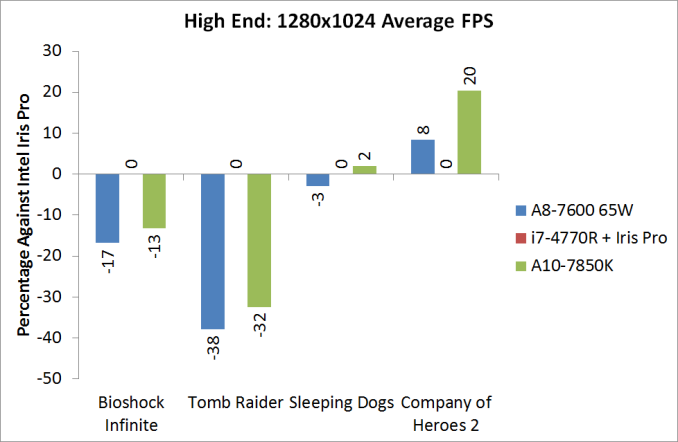
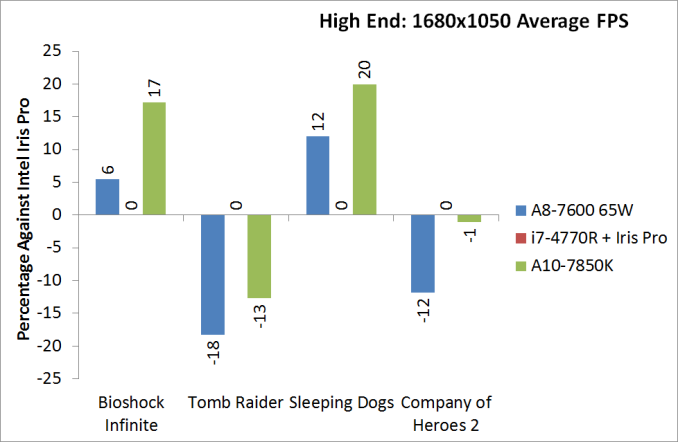
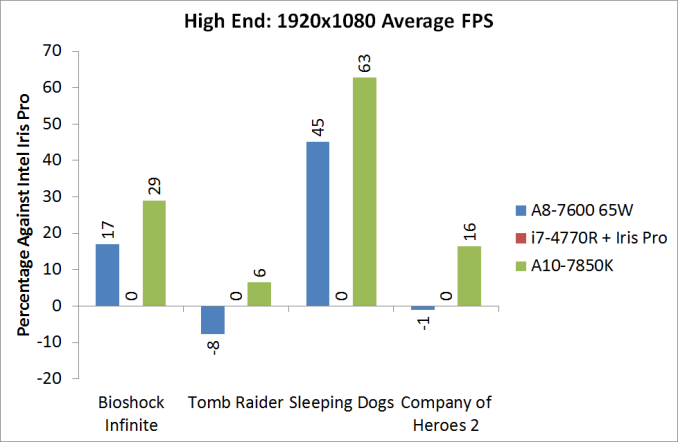








380 Comments
View All Comments
jaydee - Tuesday, January 14, 2014 - link
I just don't "get" adding three $300 Intel CPU's to a review of 3 sub $200 AMD CPU's. We all know, or can find out how i7 SB, IB, Haswell compare to each other. I can see adding one of these CPUs to show a baseline of how AMDs top-of-the-line compares against Intels (albiet at very different price points), but having all three of them gives the impression that you want to make sure everyone knows who's boss...Is there going to be an update on power draw? I'm really curious to see what the 45W Kaveri draws (idle and full power) considering it is so competitive with the 95W Kaveri.
jaydee - Tuesday, January 14, 2014 - link
I stand corrected, four $300+ Intel i7 CPUs in this comparison, not three. And two Intel CPU's that are actually in the price range of the AMDs. It feels as if to do this review, AT just cobbled together whatever was laying around instead of being intentional about putting together the best test bench possible to compare the review product against its real competitors.It's really a shame, because the commentary, the in-depth look at the architecture and the conclusions are outstanding; no website out there has tech writers as good and do as thorough of a job as Anandtech. The fact that the test benches are just after-thoughts in some of these reviews are really disappointing.
UtilityMax - Tuesday, January 14, 2014 - link
I think this was mentioned somewhere in the beginning of the review. Intel likes to have the i7 reviewed instead of other parts, so the send the i7 CPUs to everyone. This is kind of like what the car makers do. Most people just buy a reasonably priced, mid-spec car model. However, the journos always get to review these ridiculously over-optioned cars, that hardly sell, like the $35 Ford Fusions, even though the base car sells for 10 grand less.jaydee - Tuesday, January 14, 2014 - link
I am well aware that when having the choice, Intel would rather you review a $340 Intel CPU against a $179 AMD CPU. But is there not any way, given the ad revenue of Anandtech, to obtain a $190-200 mid-range Intel i5 CPU (such as the i5-4440) in order to have a relevant test bench for an eagerly anticipated AMD mid-range CPU launch?srkelley - Tuesday, January 14, 2014 - link
"...do any AnandTech readers have an interest in an even higher end APU with substantially more graphics horsepower?"Yes, oh yes! I'm letting the APU be the core of my system build in a few months and plan to upgrade as needed. I'd like a simple solution like an APU instead of having to go with a discrete card right away. If it lets me spend more on ram and other things, keep the psu and power draw low I'm happy. The most demanding game that I play right now is the Witcher 2. Eventually I will have to go discrete for Star Citizen and the Witcher 3 but if I can get solid enough results with a high powered apu then I'll simply jump to that instead.
Conduit - Tuesday, January 14, 2014 - link
This has been a long time coming thanks to Always Major Delays (AMD). Even know they can't get their sh!t together.nissangtr786 - Tuesday, January 14, 2014 - link
http://techreport.com/review/25908/amd-a8-7600-kav...The fpu still not improved miles still behind intel.
http://browser.primatelabs.com/geekbench3/326781
http://browser.primatelabs.com/geekbench3/321256
A5 - Tuesday, January 14, 2014 - link
"do any AnandTech readers have an interest in an even higher end APU with substantially more graphics horsepower? "Maybe in the context of a Steam Machine? But for my main gaming PC, no way. Maybe something they can try out after the next die shrink if SteamOS really takes off.
Xajel - Tuesday, January 14, 2014 - link
I believe the main reason for AMD to not have a new FX is SOI process.. it was okay in it's glory days, but it can't keep it up with bulk silicon...They want to increase the clock at least but they're trapped with 32nm SOI, and why not moving toward 28nm or lower SOI because I think that AMD is already working to convert it's entire CPU's to Bulk Silicon, so it's not logical to make a new design for still not ready yet 28nm or lower SOI while they are already designing the new core for bulk silicon.. knowing that both SOI and bulk require a complete redesign of the silicon just to convert from one to another... so it's not even logical to convert Pilediver or maybe even Steamroller to bulk silicon for only one year while they're working on the next architecture which will be Bulk Silicon...
jimjamjamie - Thursday, January 16, 2014 - link
That makes sense, I was very confused as to why AMD were not going to refresh the FX line - even if HSA is the future for AMD, I presumed new FX sales throughout this year would have helped things along.Perhaps it wasn't worth the cost, but at the same time AMD could really do with keeping the fanboys on side.